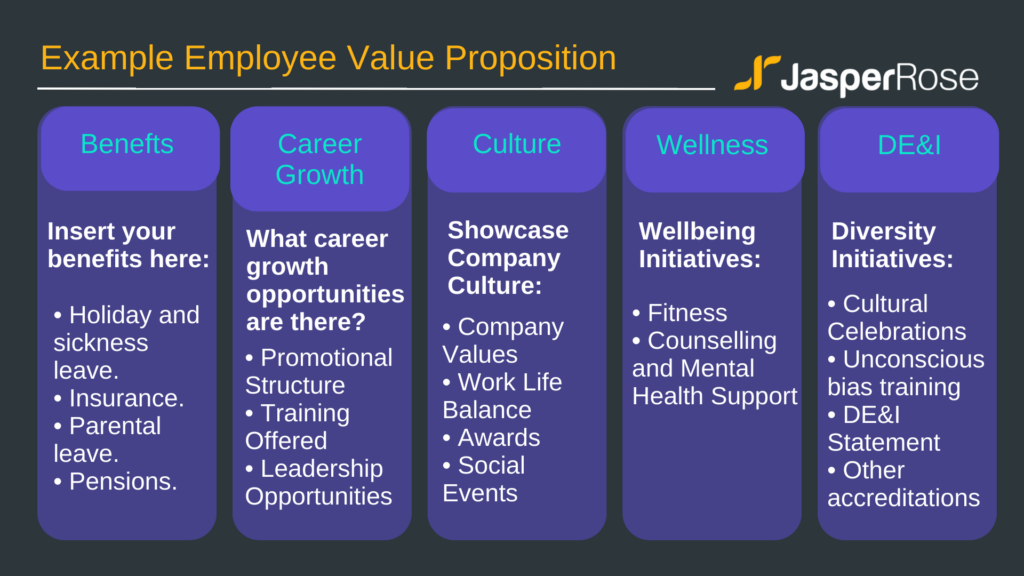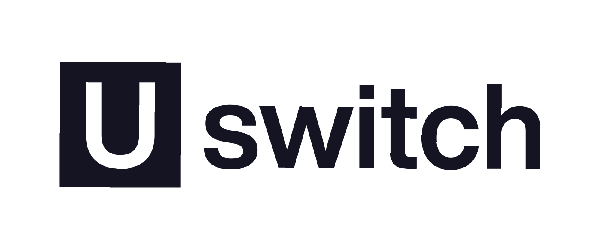What is an Employee Value Proposition (EVP) and How to Create One
An Employee Value Proposition is the unique set of benefits and rewards that an employer offers to its employees in exchange for their skills, experience, and time. It is essentially the answer to the question, “Why should I work for this company?”
First steps to creating an Employee Value Proposition:
At JasperRose, we defined our EVP when we founded our business in 2015, and it has evolved with us ever since at the forefront of our business’ strategy. Creating an EVP involves several steps. First, you need to understand your company’s culture, mission, and goals. You also need to assess the needs and preferences of your target audience, which includes your current and potential employees. This can be done through surveys, focus groups, and interviews.
Once you have this information, you can start crafting your proposition. The key is to focus on the benefits and rewards that are most important to your target audience. This could include things like competitive salary and benefits packages, opportunities for career growth and development, a positive work environment, flexible work arrangements, and a strong company culture.
It’s important to note that an employee proposition is not just a marketing tool. It should accurately reflect the reality of working for your company and be consistently communicated to employees and potential hires. By creating an effective EVP, you can attract and retain top talent, build a strong employer brand, and ultimately drive business success.
This article covers five steps that break down how to create an employee value proposition:
- Identify your target audience or Employee Persona
- Conduct Research
- Creating your EVP (Examples listed)
- Market and communicate your EVP
- Evaluate and update your EVP
1. Identify your target audience or Employee Persona:
First things first, you need to determine the type of employees you want to attract and retain. Think about seniority, whether they are contract or permanent, what personality types would benefit your team. Once way to do this would be to create an ‘Employee Persona,’ in which you create a hypothetical employee and answer a series of questions about that employee, to create your ideal persona. This employee would then be what you are looking to attract. Consider the needs, motivations, and values of this persona before curating your Employee Value Proposition. There are a variety of Employee Persona templates on Canva to get you started, or, if you don’t have this software, you could use a word or google document. If you create an Employee Persona, it is also a good idea to share this persona with any recruiters that you are working with, such as ourselves, as this could help us to find your ideal candidate.
When completing this step, also remember to bear in mind Diversity, Equity and Inclusion to avoid discrimination and unconscious bias. Try to make sure that your criteria for an ideal employee is in line with 2020’s Equality Act and use open language to avoid accidentally excluding certain genders, ethnicities, ages, disabilities, and to attract as much high-value talent as possible.
2. Conduct research:
The next step towards creating your Employee Value Proposition is to gather information from current and former employees to understand what they value most about working in your organisation, and what attracted them to the company. You can use surveys, focus groups, or interviews to collect this data. The results may surprise you. This is a great way to determine what may attract future employees. It is also worth considering your company benefits package, and evaluating what might be the most appealing in your EVP. At JasperRose, for example, we recently surveyed our employees on what benefits they would value the most, and based on their feedback, we reformed our benefits package and updated our proposition. This EVP, along with the new benefits package, is now readily available across our team.
3. How to create your EVP – with examples:
Bring together all the data that you have collected and present it. This can be in the form of infographics, an EVP statement, a pdf, even a web page. Either way, it should be easy to promote and attach to job adverts for your company. A good way to approach an EVP is by structuring it into different categories, for example, benefits, wellness, career growth opportunities, company culture, and DE&I. However, there are many more ways that you can structure an EVP, depending on what you would like to highlight.
Here, we have included an outline of how you could create an EVP in the form of an infographic. The benefit of this is that it is a simple, re-usable graphic that could be inserted into job adverts, company pdfs, and more.

Another approach could be structuring your EVP as a pdf, like a CV but, instead, showcasing your company’s appeal. Some organisations also choose to create a video selling their organisation, which can be uploaded to YouTube, social media, or your website, and the link can be attached to job adverts or sent directly to applicants. It can also be shared with recruiters that you may work with, so that we can use it as a resource in our talent search.
If you would like to see an example of JasperRose’s publicly available EVP, please contact us and we would be happy to share the pdf with you directly. We also use different platforms for attracting talent, such as our company website and our social media.
4. Market and communicate your EVP
Once you have created your EVP, it is important to share it with both potential and current employees. For current employees, it may be a reminder for why they want to work with you, and it could highlight your company’s benefits. It is important to use various communication channels, such as your company website, email, job descriptions, social media, and employee onboarding materials. This is a re-usable value piece, that can serve you again and again in your talent search.
5. Evaluate and update your EVP
A company is something that evolves with time. The market could change, or your organisation’s needs, your team structure, your benefits package. Regularly review and update your proposition to ensure it aligns with the evolving needs and expectations of your employees. Request feedback and adjust your EVP accordingly to ensure its longevity and that it accurately reflects your organisation in the long run.
In Summary:
This article answers the question “what is an Employee Value Proposition (EVP) and how to create one?” as we frequently come into contact with clients asking us how to attract, market to, and retain talent within their organisation. Of course, this is just one of many methods for achieving this, but it is one way to ensure that the benefits of working with you are clearly communicated to your staff, applicants, and the recruiters that you partner with.
Overall, conducting research and creating an employee persona are great places to start when developing your Employee Value Proposition. Then, decide on the format that is most applicable to your organisation (video, infographic, pdf…), and ensure a clear structure. After creating your proposition, ensure to market it both internally and externally, and update your EVP over time to ensure that it stays relevant. If you would like help attracting employees to your business, specifically talent leaders within the finance space in the consumer sector in London, we would love to assist you on your hiring journey at JasperRose. If this is the case, please get in touch with us here.



















































